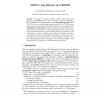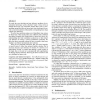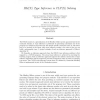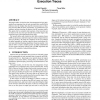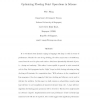ECOOP
2012
Springer
12 years 10 months ago
2012
Springer
Ownership type systems describe a heap topology and enforce an encapsulation discipline; they aid in various program correctness and understanding tasks. However, the annotation ov...
CAV
2012
Springer
12 years 10 months ago
2012
Springer
We present CSolve, an automated verifier for C programs based on Liquid Type inference. We show how CSolve verifies memory safety through an example and describe its architecture...
DLS
2009
14 years 5 months ago
2009
Type inference and type reconstruction derive static types for program elements that have no static type associated with them. They have a wide range of usage, such as helping to ...
ER
2010
Springer
14 years 5 months ago
2010
Springer
In this paper we describe a method to perform type inference over data stored in an RDBMS, where rules over the data are specified using OWLDL. Since OWL-DL is an implementation of...
PPDP
2010
Springer
14 years 5 months ago
2010
Springer
We study the type checking and type inference problems for intuitionistic linear logic: given a System F typed λ-term, (i) for an alleged linear logic type, determine whether the...
JFP
2008
14 years 6 months ago
2008
The HM(X) system is a generalization of the Hindley/Milner system parameterized in the constraint domain X. Type inference is performed by generating constraints out of the progra...
APLAS
2010
ACM
14 years 6 months ago
2010
ACM
We consider programming language aspects of algorithms that operate on data too large to fit into memory. In previous work we have introduced IntML, a functional programming langu...
PVLDB
2008
14 years 7 months ago
2008
This paper studies, for the first time, the management of type information for an important class of semi-structured data: nested DAGs (Directed Acyclic Graphs) that describe exec...
JCSS
2002
14 years 7 months ago
2002
A database programming language is a programming language extended with database operations. In this paper we extend a core functional language with explicitly labeled tuples and ...
CL
1999
Springer
14 years 7 months ago
1999
Springer
It is well known that dynamic typing in languages like Lisp is costly in terms of performance. Besides the cost of tag checking, the other major source of ine ciency comes from th...

